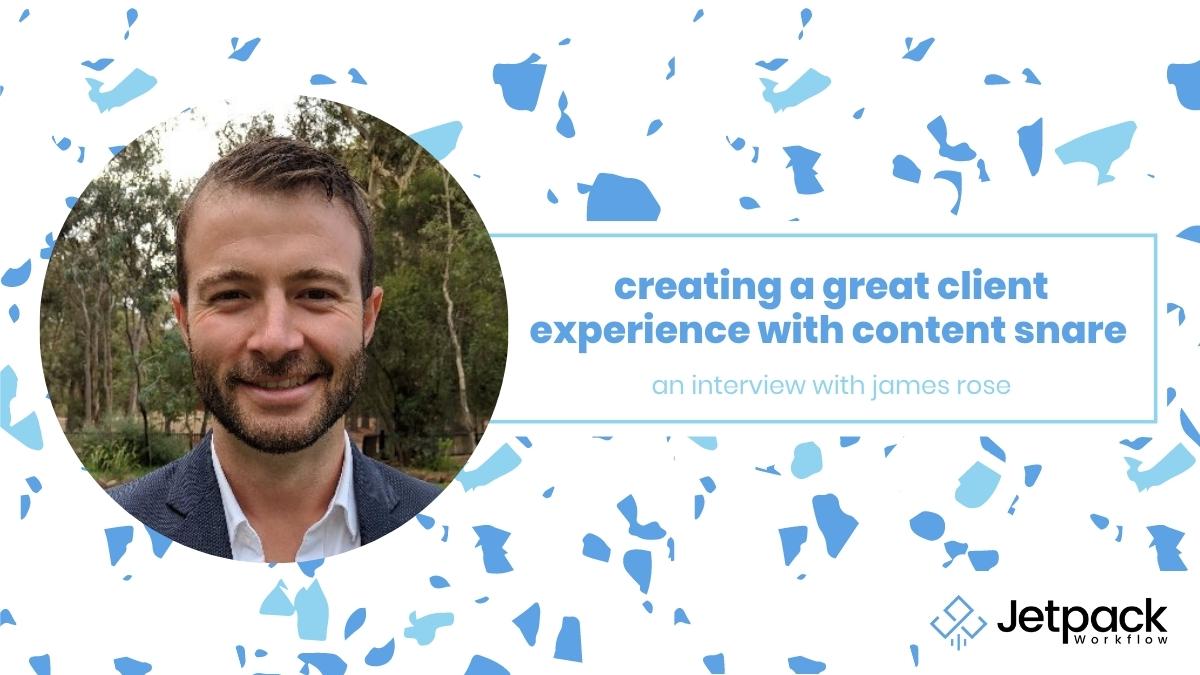Creating A Great Client Experience With Content Snare

Podcast
Summary
- What is Content Snare?
- Creating a Great Client Experience
- How Much Information Is Too Much?
- Needs From Different Industries
- Integrating With Zapier
- Final Thoughts
Additional Resources
- contentsnare.com
- James’ Email: james@akturatech.com
- James’ LinkedIn
- James’ Twitter
- Filesharing Solutions: Dropbox, FileRequest, G-Suite
Meet James Rose
James Rose is the co-founder of Content Snare—a software platform that helps professionals collect content and files from clients. Once an automation engineer, his new priority is to help business owners regain their lives, be more productive, and get more done in less time.
What is Content Snare?
The product was originally designed for web designers, but the product provides a service that answers an issue that is common across many industries: client information collection.
At a high level, Content Snare can be thought of as an electronic checklist that you would send to your client in a space where they can answer questions and upload images all in one place. It makes it easy to gather info and documents from your clients.
If the client doesn’t provide everything that’s needed, it will send automatic reminders to make sure you get what you need. This enables you to focus on higher-value work while making the process easy for your clients.
Creating a Great Client Experience
Businesses and clients alike face challenges whereas information collection is concerned. Businesses feel like they have to chase and hassle their clients to get the information they need, and clients often view the data collection method as being overly complex or tedious. That’s why creating a great client experience is so important when it comes to collecting information.
“The biggest thing to keep in mind is that it has to be dead simple for clients,” James explained. “Basically, if you’re working with business owners or other professionals, they’re going to be super busy, just like you.” Essentially, your clients may not have time to figure out a system that is difficult to use. Because they are so busy, many business owners have to prioritize their tasks, and if your system is viewed as complicated to use, your task is going to be pushed to the bottom of their to-do list.
James suggested creating a simple workflow so they know where to go and what they’ve got to do, and then guide them through the process. “No logins is a good one as well,” said James. “I know a lot of people use them; they seem to be quite popular in the accounting industry.” This may seem counterintuitive to some who are trying to create a secure space for clients to share their information. However, James recommended meeting your clients where they are.
“Use something like a file request tool, like Dropbox, or meet the client where they are. If they’ve got Google, you can create file requests within that space.” While this may make things a bit more difficult for you, it creates an easier and more enjoyable experience for your clients. But what about Content Snare?
Ultimately, their goal is to have a product that doesn’t use client logins. Presently, the product is pin code protected. “What we’re working towards in Content Snare is the ability to hide certain fields once they’ve typed something or uploaded something,” James said. For instance, if they’ve been granted access via a link and have entered their information, once they’re done entering that information the filled out information fields are hidden – even from the client if they re-click on that link after they’ve exited the page. This is important because it prevents client information from being leaked or stolen, if the client is subjected to a phishing attack.
There are a select few other products that follow this same model of information collection. The issue with those products, however, is that they require that the information be uploaded or filled in one go. “That’s one of those big tasks that gets pushed to the bottom of the pile because if that’s going to take me half an hour to fill all of that out in one go, I’m not going to do that,” James said. What Content Snare does is it chunks up those tasks into smaller, more manageable tasks that can be taken care of in 10 minutes or less.
Get everything you need to manage projects and meet deadlines.
Subscribe to our weekly newsletter, and get 32 free accounting workflow templates today!
sign me up!
When it comes to requesting client information and helping them along that process, you can definitely give too much information/instructions. “Put yourself in the client’s shoes and think about what their level of knowledge is,” James commented. You’re asking your clients to provide you with specific documents, but do they know where to find those documents? Do they know what those documents look like? In the situation that they don’t, the most helpful things you can do for them are giving them helpful instructions and not overwhelming them with information.
“So maybe it’s a couple of dot points about where to get it, where it would normally be, and a screenshot of a sample document. Maybe even a little video about where and how to get it,” said James. He recommended that you keep those videos short and to the point. You can create further instructions as needed.
One useful feature of Content Snare is that clients can ask you questions about particular instructions or requested information. If you get the same question over and over again from multiple clients, then you have a built-in system that tells you when you need to create more specific instructions.
David asked James whether or not a large portion of these issues could be solved by better client onboarding. James gave the example that his bookkeepers always had to ask him for information until one of them just asked for Stripe credentials. Was that an onboarding oversight? Not necessarily. It depends on your business and practices whether that would even be an option.
“I think a lot of the information collection process can be sorted out with good processes, but sometimes you might need a tool to help you,” James commented.
Needs From Different Industries
Many different industries use Content Snare, but David wanted to know if there are any nuanced differences between the industries’ needs, specifically if James has noticed anything particular about the accounting industry’s needs.
“There are definitely differences,” James said. “It’s crazy to me how much overlap there is between anyone with clients… Anyone who needs information from other people, they all suffer from the same problem—constantly chasing after people and never getting responses.”
Despite this general similarity, there are a few things that are particular about the needs of the accounting industry. The first thing James noted was tabular data. They implemented a table field, which is used both by accountants and mortgage brokers. Scheduled requests are also big for accountants. While this feature hasn’t been implemented yet, the Content Snare team is working on it. The most prominent particularity for accountants has been security.
“This is a very, very security-conscious industry,” James commented. “Even with the integrations, we were talking to Xero, and just to get access to Xero Practice Manager’s API… we have to jump through so many hoops to do that.”
Integrating With Zapier
Zapier, at a basic level, is an automation platform that allows you to set up workflows with specific triggers. For example, when someone fills out your contact form, Zapier would add them to your CRM.
“When a quote is signed, you might automatically send a request in Content Snare for the client to fill out your initial onboarding form,” James said. “Once they’ve filled out your requested form, you can update their information and status in your CRM.”
James commented that Zapier is a huge time saver for him. He has saved approximately 120 hours per month with all of the tasks that Zapier runs for him. He uses it for synchronization between tools. He also uses it for his weekly newsletter and while he is on the web. When he uses the Zapier Chrome extension, he is able to push articles from the web directly into his newsletters.
Final Thoughts
“One thing I always ask myself is ‘Is this extremely easy for the client to give me exactly what I need,” James said.
He recommended avoiding email. While everyone thinks that email is accessible and easy to use, it may not be the best thing for your client. For example, if you’re asking 10 questions in an email, how does your client go about responding to those questions. It may seem simple, but responding to a number of questions in long-form can be messy. PDFs, according to James, are even worse.
Conclusion
We covered a ton of great information in the podcast, so if you’re after more detailed information, be sure to check out the full episode. If you want to connect with James, you can reach him on Twitter or you can check out his website.





